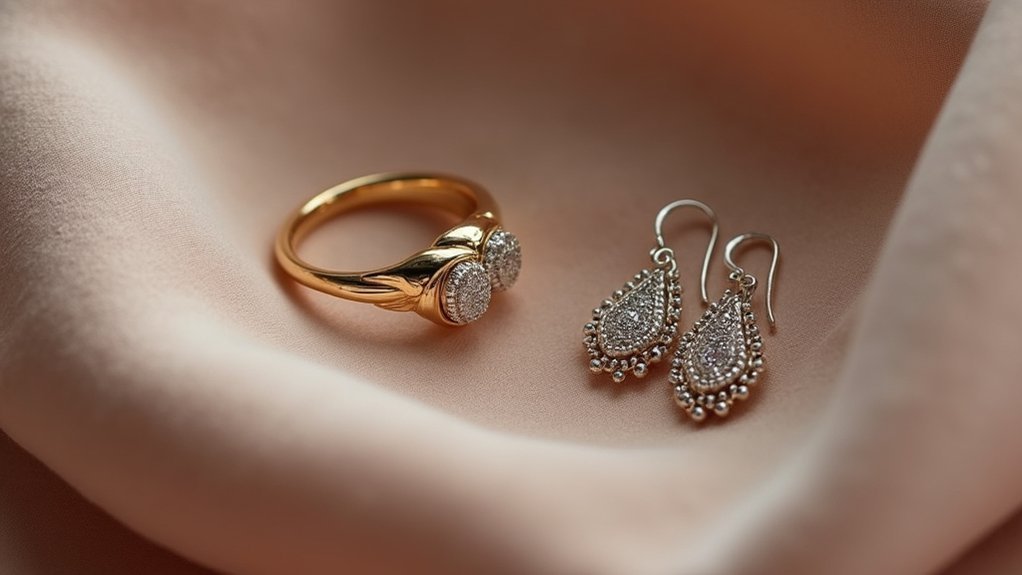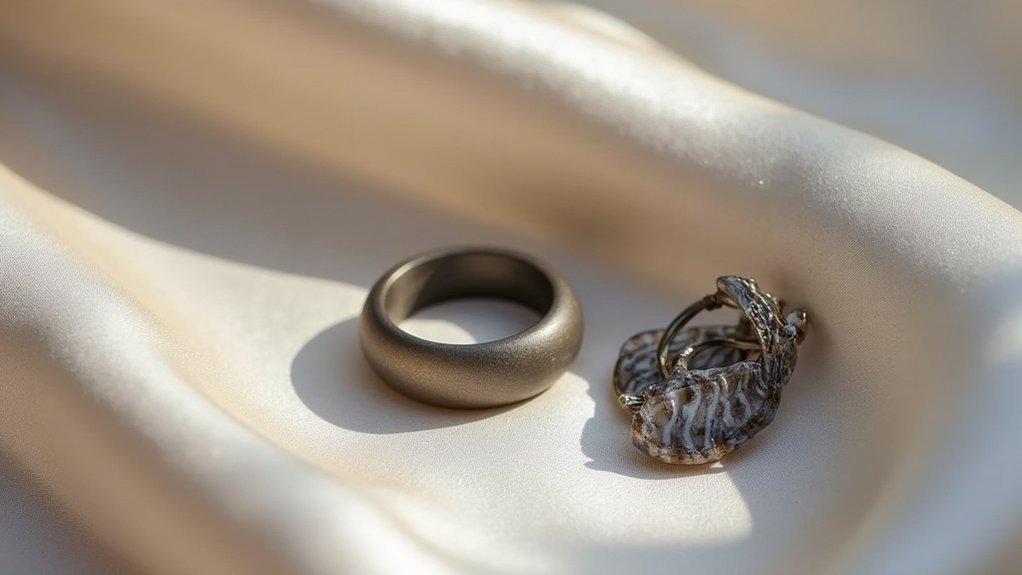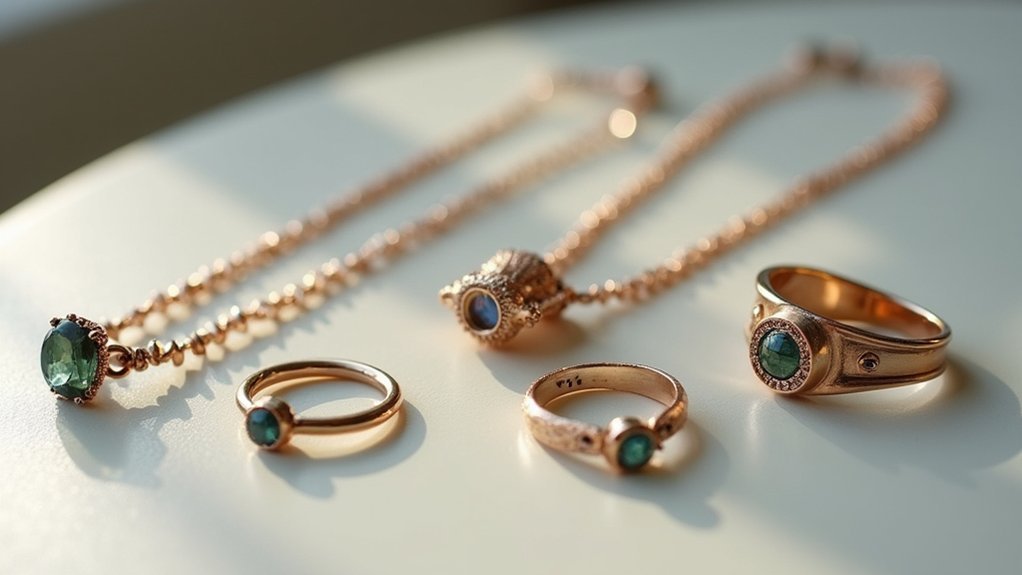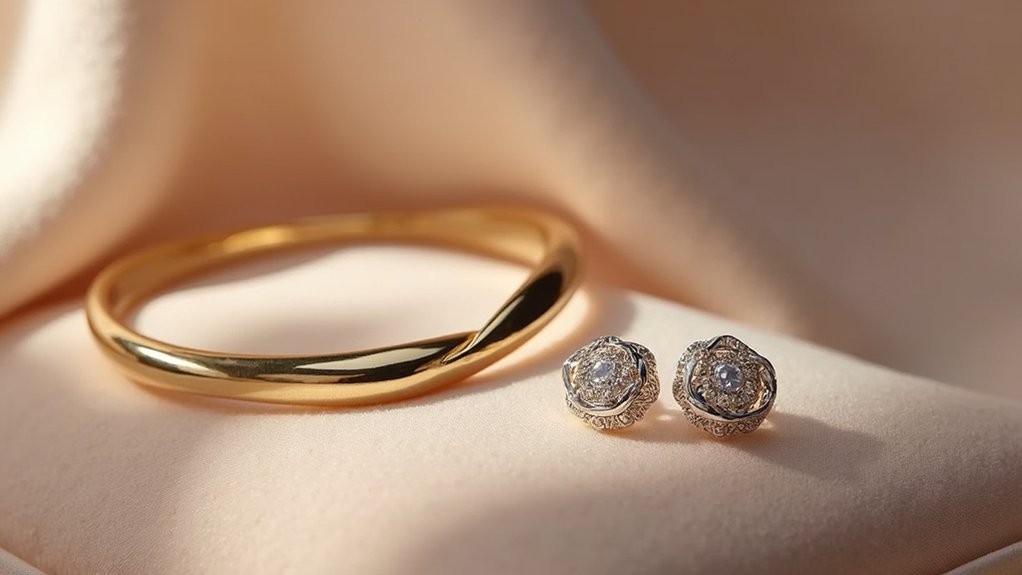You’ll create comfortable jewelry by prioritizing ergonomic design principles and user-focused materials. Focus on proper weight distribution through balanced elements, smooth rounded edges, and lightweight materials like titanium or resin. Choose accessible closures like magnetic or toggle clasps for easy manipulation, especially for users with dexterity challenges. Test your designs across diverse body types and gather regular feedback to refine comfort standards. The key lies in balancing aesthetics with functionality, ensuring your pieces become daily essentials rather than occasional accessories that sit unused in jewelry boxes.
Why Comfort Matters in Modern Jewelry Design

While stunning aesthetics have traditionally dominated jewelry design, today’s consumers increasingly prioritize comfort alongside beauty. When you wear jewelry that feels good, you’ll naturally reach for those pieces more often, increasing their overall value.
Comfort directly impacts wearability – uncomfortable jewelry pieces end up forgotten in drawers rather than being worn daily.
Modern jewelry design must balance visual appeal with physical ease. You’re more likely to develop loyalty toward brands that create pieces you can wear comfortably for hours without irritation.
This shift reflects changing lifestyles where people want versatile accessories that adapt seamlessly from work to leisure. Prioritizing comfort in jewelry design isn’t just about customer satisfaction; it’s about creating lasting relationships between wearers and their cherished pieces.
Essential Ergonomic Principles for Wearable Jewelry
When you’re designing jewelry for comfort, you’ll need to master two fundamental ergonomic principles that directly impact wearability.
First, you must consider how weight distributes across the body—poorly balanced pieces create pressure points and fatigue that make extended wear uncomfortable.
Second, you’ll want to implement closure systems that provide security without sacrificing the flexibility users need for easy handling and daily wear.
Balance and Weight Distribution
Because proper balance directly impacts how jewelry feels against your body, understanding weight distribution becomes essential for creating pieces that remain comfortable throughout extended wear.
You’ll need to distribute visual weight evenly through symmetrical arrangements or strategic placement of asymmetrical elements to prevent discomfort.
Consider these key strategies for achieving ideal balance:
- Use lightweight materials like resin and titanium to reduce overall weight while maintaining durability.
- Position larger components carefully to avoid pulling on skin or causing strain during movement.
- Employ wider, flatter ring shanks to distribute pressure evenly across your finger.
Testing your designs with various users reveals how weight distribution affects comfort.
You’ll discover adjustments that guarantee your wearable pieces feel secure without becoming cumbersome, creating jewelry that enhances rather than hinders daily activities.
Secure Flexible Closure Systems
Weight distribution works hand-in-hand with how easily you can put on and remove your jewelry pieces. Secure flexible closure systems dramatically improve accessibility for wearers with limited dexterity.
You’ll want to take into account magnetic or toggle clasps that eliminate fumbling with tiny components. Larger lobster claw clasps provide better grip for those facing hand mobility challenges.
Adjustable closures like sliding knots or extenders accommodate size fluctuations and personal preferences. They guarantee your customers can wear your designs comfortably regardless of body changes.
Elastic or stretch options in bracelets remove clasps entirely, creating effortless wearability.
Testing closure designs with diverse users reveals usability issues you might overlook. This feedback helps you refine functionality and create truly comfortable jewelry that everyone can enjoy wearing without frustration or assistance.
Material Choices That Enhance Daily Comfort

Key material features that maximize daily comfort:
- Smooth edges and rounded finishes eliminate pressure points and chafing.
- Adjustable sizing components that accommodate body changes throughout the day.
- Elastic or stretch elements in bracelets that eliminate restrictive clasps.
These thoughtful material choices guarantee your jewelry enhances rather than hinders your daily activities, making comfort-focused pieces genuine lifestyle accessories.
Creating Accessible Jewelry for Diverse Needs
When you’re designing jewelry for diverse needs, you’ll want to focus on adaptive clasp solutions that work for people with limited dexterity—think magnetic closures, toggle clasps, or oversized lobster claws that don’t require fine motor skills.
You should also prioritize hypoallergenic materials like surgical steel or silicone to accommodate users with metal sensitivities or allergies.
Additionally, you’ll need to incorporate adjustable sizing features that can accommodate fluctuating body measurements and guarantee a comfortable fit across different body types.
Adaptive Clasp Design Solutions
Although traditional jewelry clasps work well for many people, they can create significant barriers for individuals with limited dexterity, arthritis, or other physical challenges.
Adaptive clasp design solutions can transform your jewelry into accessible pieces that everyone can enjoy independently.
Consider these effective accessibility improvements:
- Magnetic clasps – Provide effortless connection with simple proximity
- Toggle clasps – Offer easier manipulation with larger grip surfaces
- Elastic designs – Eliminate clasps entirely for seamless wear
Larger lobster claw clasps improve grip strength requirements, while adjustable sizing features like extenders accommodate fluctuating needs.
These modifications create a user-friendly experience without compromising style.
Testing your designs with diverse users guarantees real-world functionality.
Hypoallergenic Material Selection
Skin sensitivities affect millions of jewelry wearers, making material selection a critical factor in creating truly accessible designs.
When you’re choosing hypoallergenic materials, prioritize surgical stainless steel and titanium for their proven track records with sensitive skin. You’ll want to avoid nickel entirely, as it’s the most common culprit behind metal sensitivities and allergic reactions.
Consider incorporating nickel-free alloys that maintain durability without compromising comfort.
Silicone offers exceptional flexibility for bracelets and earrings, allowing extended wear without irritation. You can also explore resin and natural fibers as lightweight alternatives that won’t trigger reactions.
Always test your material choices with users who’ve documented allergies. Their feedback guarantees your designs truly serve diverse needs while maintaining the aesthetic appeal your customers expect.
Adjustable Sizing Features
Since body sizes naturally fluctuate throughout the day and across different life stages, you’ll find that adjustable sizing features transform jewelry from restrictive accessories into adaptable companions.
These mechanisms enhance wearability by accommodating individual comfort levels and physical changes.
When designing custom jewelry with inclusive designs, consider implementing:
- Sliding clasps and adjustable links that allow easy customization without tools
- Elastic or stretch components that eliminate clasps for users with limited dexterity
- Expandable rings and variable-length chains that adapt to size fluctuations
You’ll discover that incorporating adjustable sizing features remarkably broadens your market appeal, attracting diverse audiences who value comfort and accessibility.
Regular feedback from users with varying physical needs helps refine these features, ensuring your designs effectively serve individuals with different limitations while maintaining aesthetic appeal.
Clasp and Closure Solutions for Easy Use
While beautiful jewelry can enhance any outfit, it’s useless if you can’t put it on or take it off comfortably. The right clasp and closure solutions dramatically improve wearability and comfort for everyone, especially those with dexterity challenges.
Magnetic clasps provide secure yet easily detachable connections, perfect if you have limited mobility. Toggle clasps offer straightforward fastening that you can manipulate with one hand while combining style with functionality.
Magnetic and toggle clasps deliver effortless one-handed operation while maintaining security and style for those with mobility limitations.
When choosing lobster claw clasps, opt for larger versions that enhance your grip—they’re ideal if arthritis affects your fine motor skills.
Consider elastic or stretch options that eliminate clasps entirely. These allow bracelets to slip on and off without hassle.
Additionally, incorporate adjustable sizing features into any closure system to guarantee comfortable fits across various wrist sizes and accommodate fluctuating measurements.
Weight Distribution and Balance Techniques

Even the most stunning jewelry becomes unwearable if it’s poorly balanced or too heavy for comfortable wear.
Mastering weight distribution and balance techniques guarantees your jewelry designs remain both beautiful and functional throughout extended wear.
You’ll want to strategically balance heavier components like large gemstones with lighter materials or smaller decorative elements.
Consider incorporating lightweight alternatives such as resin or titanium to reduce overall weight without compromising visual impact.
Asymmetrical designs with thoughtful element placement create dynamic balance, preventing pieces from shifting excessively on the body.
Key balance techniques for comfortable wear include:
- Testing on various body types to gather feedback on weight distribution
- Using wider, flatter band shanks in rings to distribute pressure evenly
- Positioning heavy elements near the body’s center of gravity
These approaches guarantee your jewelry designs prioritize both aesthetics and wearability.
Testing and Refining Your Designs for Maximum Wearability
Although creating balanced and lightweight jewelry sets the foundation for comfort, rigorous testing transforms good designs into exceptional ones that truly serve diverse wearers.
You’ll need to conduct wearability tests with users across different ages, abilities, and body types to identify potential discomfort or accessibility issues. Implement a thorough wearability checklist evaluating comfort, ease of use, and sizing flexibility for each piece in your jewelry creation process.
Focus on incorporating adjustable sizing features like expandable rings and variable-length chains to accommodate body fluctuations. Choose lightweight materials such as resin and titanium to reduce strain during extended wear.
Most importantly, you must regularly review feedback and update your designs accordingly. This continuous refinement cycle guarantees your jewelry meets evolving comfort standards while maintaining aesthetic appeal.
Frequently Asked Questions
How Much Does It Cost to Design Your Own Jewelry?
You’ll typically spend $300-$3,000+ designing custom jewelry, depending on complexity and materials. Gold costs about $60 per gram, while consultations run $50-$200 hourly. Labor represents 30-50% of total costs, plus additional fees.
What Are the Principles of Design in Jewelry?
You’ll apply five key principles when designing jewelry: balance distributes visual weight, proportion maintains harmony between components, contrast creates interest through differences, unity guarantees cohesive elements, and emphasis establishes focal points.
What Type of Jewelry Is a Perfect Choice for Daily Wear?
You’ll find lightweight pieces with adjustable sizing perfect for daily wear. Choose titanium or resin materials, magnetic closures, and versatile designs like stud earrings or pendant necklaces that shift seamlessly throughout your day.
How Do You Come up With Jewelry Designs?
You’ll start by gathering inspiration from nature, art, or personal experiences. Create mood boards with colors and textures, then sketch multiple concepts. Experiment with materials and collaborate with skilled jewelers to realize your vision.
In Summary
You’ll transform your jewelry designs by prioritizing comfort alongside beauty. Remember that ergonomic principles, thoughtful material selection, and accessible features aren’t just trends—they’re essential for creating pieces people actually want to wear daily. Test your prototypes thoroughly, listen to feedback, and don’t be afraid to refine your designs. When you master the balance between aesthetics and wearability, you’ll create jewelry that truly enhances your customers’ lives.





Leave a Reply